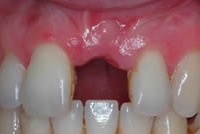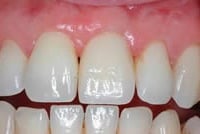Dental Implants
People lose teeth all the time, either through trauma (when teeth are knocked out) or due to decay, gum disease or old age. Whatever the reason for losing your teeth, they need to be replaced, both for aesthetic and functional reasons. The most common treatments for missing teeth are either a denture or a fixed bridge. However, dental implants are now becoming a more popular treatment to replace missing teeth, as they provide a longer-term solution, slow down bone loss and preserve nearby healthy tooth tissue.
What is a dental implant?
A dental implant is an artificial substitute/replacement for the root portion of your natural tooth and is anchored into a pre-drilled socket in your jaw-bone to support a crown, bridge or secure a denture firmly in place. Implants are made from titanium, a material that is well tolerated by bone and integrates easily with bone tissue. During the placement of a dental implant, the goal is to achieve a close contact between the outer surface of the implant and the surrounding bone tissue so they can “fuse” together (osseointegration), creating a stable support for the new teeth.
|
|
 |  |
| The above case demonstrates a single tooth replaced with a dental implant and crown. | |
How is a dental implant placed?
Before any implants are placed, it is important for your dentist to assess the health of your teeth and gums. If there are any signs of gum disease or decay, these must first be treated. Thereafter, your treatment will be planned following several x-rays and, in some cases, a CT scan to assess that bone quality and check for nearby anatomical structures to avoid before any drilling. The procedure is usually carried out under local anaesthesia; IV sedation is sometimes used if it is a long procedure or the patient is very anxious.
The gum where the implant is to be placed is cut and lifted and a small hole is drilled in the jawbone at the precise location of the intended implant. The titanium implant is tightly fitted into this socket and the gum is stitched back over the implant. If there is insufficient bone material to accommodate the implant, a bone graft may be required, or the dentist may use smaller-sized mini implants if suitable.
Once the implant has been placed, it is left to heal and integrate with the jawbone for between six weeks to six months. The bone tissue will grow and anchor itself into the microscopic rough surface of the implant.
During this “healing period”, patients are given temporary teeth (bridges) or continue to wear dentures. It is important that temporary teeth do not exert any force on the healing implant. After the healing period, the gum is again lifted and a post is attached to the implant with a temporary crown. Four to six weeks later, when the surrounding gum tissue has matured, the final permanent restoration can be fitted to the implant.
What are the advantages of dental implants over dentures and bridges?
- Reduced bone loss
Normally, the bone tissue surrounding the root of your tooth is maintained by your body’s natural renewal process. However, if you loose a tooth, you will be left with a hole where your tooth root used to be and the bone around this area will slowly begin to disappear (atrophy) which may change the shape of your jaw. A dental implant placed in that area can actually stimulate bone growth and production, preventing loss of valuable bone structure. In some patients where bone loss is substantial, a bone graft may be required before placing a dental implant. Bone loss is a problem for people who have dentures, and as the shape of the jaw slowly changes, the dentures need to be adjusted or re-made to fit the new shape of the jaw. Bone loss can also make a person look older, since the area around the mouth can sag as bone is lost - Improved function
Once dental implants are fully integrated into your jaw, they function just as well as your own natural teeth: you can eat the foods you want and speak with complete confidence. With dentures, eating hard foods such as an apple can be a problem: either the dentures come loose or patients cannot withstand the hard biting forces as they cause pain in the gums. Irritation and inflammation of the gums is a common problem amongst denture patients. Dentures can be supported by implants or mini-implants, which will greatly improve function, enabling patients to eat the foods they want with complete confidence and not having to worry about bone loss and loose dentures falling out. - Improved dental hygiene
Unlike bridges and dentures, which require special cleaning instructions and extra attention, dental implants just need regular brushing, flossing and dental hygiene appointments, just like your natural teeth. - No need to drill or remove any healthy tooth structure
When replacing missing teeth with dental bridges, the teeth adjacent to the gap need to be prepared and healthy tooth structure is removed to accommodate a crown or bridge abutment to fit over the top of the tooth. In the future, if one of the supporting teeth is damaged, the entire bridge restoration will also be compromised, whereas with an implant, the restoration is independent of any of your other teeth. By replacing lost teeth with an implant, no support is required of the adjacent teeth, and your natural teeth do not need to be prepared or altered in any way - Better aesthetics
If done correctly, a dental implant should be indistinguishable from your surrounding natural teeth. Dentures can come loose and look unnatural if they do not blend with your gums, and some bridges and dentures have unsightly metal clasps to hold them in place. Dental implants provide a much better cosmetic and functional end result.



How many teeth can a dental implant support?
Traditionally, an implant placed into your bone supports a single crown and this is know as a “single tooth implant”. However, if you have several missing teeth, you do not necessarily need an implant for every missing tooth: one implant can support several teeth via a bridge or denture. The number of implants required depends on the volume and density of bone tissue available at each implant site. Often, smaller-sized “mini implants” are used to secure dentures in place.
In the case of full-mouth reconstructions, where an arch of several teeth (10+) needs to be supported in either the upper or lower jaw, a minimum of five to six implants in each jaw would be required. The exact number of implants needed would depend on the individual case and your implant surgeon would be able to advise you on the best solution after a thorough examination and assessment.
Am I a suitable candidate for dental implants?
Dental implants can be placed in patients of any age (with fully developed jawbones), provided that they have a sufficient quantity and quality of bone tissue available. Most healthy individuals that maintain a good oral hygiene program are suitable candidates for dental implants. Circumstances where implants may not be suitable, or situations that have an increased risk of implant failure, include:
- Heavy smoking – this slows down and hinders the healing process.
- Excessive alcohol intake – disrupts healing of the gums.
- Periodontal gum disease – all active gum disease must be treated prior to any implant procedure to ensure the long-term success of any treatment. Periodontal disease is a major cause of bone loss, which would hinder the success of any implant procedure.
- Immuno-compromised individuals (steroids, auto-immune disease, patients undergoing radiation treatment).
- Teeth grinders (bruxism) – a night-time splint can be given to treat this.
How will I know if I have enough bone for implants?
Using a combination of dental X-rays and a CT scan, your bone density and volume can be assessed, and information about nearby anatomical structures to avoid (such as nerves) can also be gathered.
What if I don’t have enough bone for dental implants?
The alternatives for replacing missing teeth include dentures and bridges. However, there are various bone-grafting and tissue-regeneration procedures that can be carried out to enable treatment with dental implants:
Sinus augmentation – if you need to replace missing teeth at the back of the upper jaw, a sinus augmentation, whereby new bone in the sinus is created, can increase the height of the bone available for the placement of implants in this area.
Onlay grafting – this is where a piece of bone is taken from somewhere else and secured over an area that is deficient in bone; over time, the newly placed bone will fuse with the underlying bone creating a better environment for an implant to be placed.
Where can bone be taken from for the graft?
The best source of bone for your graft is your own bone tissue from elsewhere in your body. Bone can be grafted from the chin, the back of the lower jaw, the hip and the tibia. Bone taken from your own body is the most viable and has faster healing times when compared to alternatives. In many cases, a combination of artificial bone substitutes and your natural bone is used. In any bone grafting procedure, the grafted bone provides an anchor and stimulus for the existing bone to grow onto, eventually providing an environment suitable for the placement of implants.
How long do dental implants last?
Dental implants have been used for over 30 years to replace missing teeth and they can last a lifetime depending on how well you look after them. Like any other restoration, your implant-supported teeth can still be damaged by trauma and affected by gum disease and poor oral hygiene.




